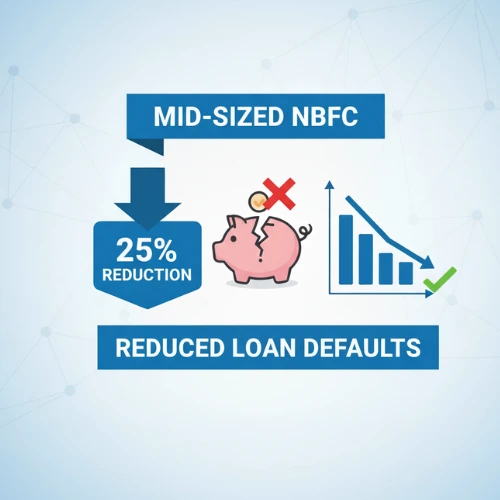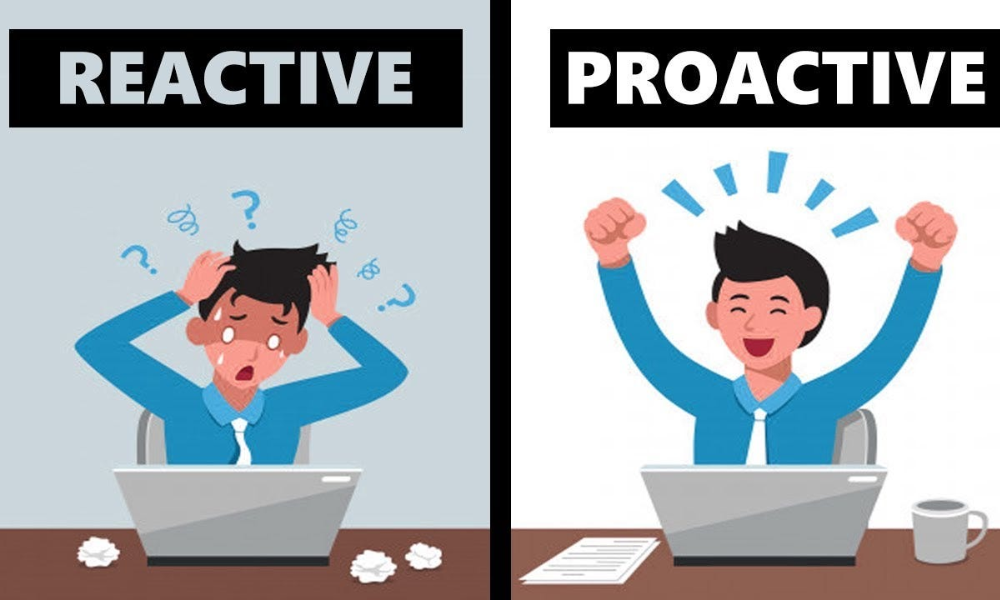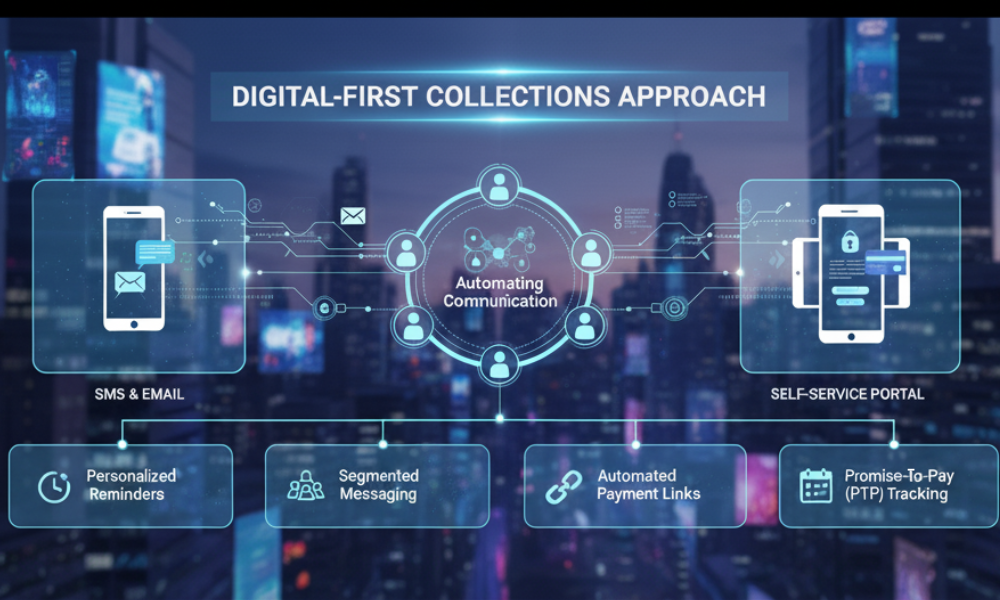
Discover how a mid-sized NBFC cut loan defaults by 25% in this detailed loan default case study. Learn their strategies using loan management software, predictive analytics, and digital collections to improve portfolio health and collection efficiency.
Introduction
Loan defaults don’t just dent books—they drain momentum. In this loan default case study, see how a mid-sized NBFC reduced loan defaults by 25% in two quarters by shifting from reactive chasing to proactive prevention. The turnaround hinged on three levers: smarter underwriting with a rule engine and bank statement analytics, an Early Warning System that flagged risk before EMI due dates, and digital-first collections with payment links, eNACH retries, and disciplined PTP tracking. The result was fewer rollovers from 0–30 DPD, higher right‑party contacts, and a smoother customer experience. Along the way, the team strengthened compliance, improved agent productivity with a field app, and built dashboards that spotlighted roll rates, PTP kept %, and eNACH success. If portfolio health, NPA reduction, and collection efficiency are priorities, this playbook shows what works—and how to execute it without slowing disbursals.
The Challenge: When Growth Outpaces Collections
Let’s call our subject “FinGrowth NBFC,” a mid-sized lender specializing in unsecured personal and small business loans. Like many in the sector, they were experiencing impressive growth. But beneath the surface, a problem was brewing. Their Gross NPA ratio was climbing, and their collection efficiency was dropping, especially in the early delinquency buckets (0-30 days past due).
Their collections process was almost entirely manual and relied on three pillars:
- A large team making phone calls from spreadsheets.
- Field agents making visits with little to no real-time data.
- A basic reminder system that sent generic SMS alerts.
This approach was not only expensive but also inefficient. Agents spent more time on administrative tasks than on actual collections, communication was inconsistent, and there was no data-driven way to prioritize high-risk accounts. The reasons for loan defaults ranged from genuine financial hardship to simple forgetfulness, but FinGrowth had no way to tell the difference.
The Turning Point: Shifting from Reactive to Proactive Risk Management
The leadership at FinGrowth realized that to achieve sustainable growth, they needed to stop reacting to defaults and start preventing them. The goal was to build a system that could identify potential defaulters early and engage them with the right message at the right time. This required a fundamental shift in strategy, powered by robust loan management software and data analytics. They developed a three-pillar strategy that ultimately transformed their portfolio health.

The Strategy That Delivered a 25% Reduction in Defaults
Instead of a complete overhaul, FinGrowth focused on three strategic areas where technology could deliver the highest impact
Pillar 1: Implementing an Early Warning System (EWS) with Predictive Analytics
The first step was to get smarter about risk. Traditional credit bureau scores provided a static snapshot at the time of underwriting, but they couldn’t predict future behavior. FinGrowth implemented a predictive analytics model to create a dynamic Early Warning System (EWS).
This system analyzed a wide range of data points to generate a real-time risk score for each borrower:
- Repayment History: Analyzing past payment behavior for patterns.
- Transactional Data: Using tools to analyze bank statements for signs of financial distress, such as frequent cheque bounces or a declining account balance.
- Behavioral Data: Tracking how customers interacted with the NBFC’s app and website.
- Alternate Data: Incorporating non-traditional data points for a more holistic view, especially for customers with thin credit files.
By leveraging machine learning, the EWS could flag accounts at high risk of default before they missed a payment. This allowed the collections team to move from being “collectors” to “financial wellness partners,” proactively reaching out to high-risk customers to offer assistance or flexible payment options.
Pillar 2: Automating Communication with a Digital-First Collections Approach

With the EWS identifying who to contact, the next step was to improve how they were contacted. FinGrowth deployed a collections CRM to automate and personalize communication across multiple channels.
The new digital collections workflow included:
- Personalized Reminders: Instead of generic texts, the system sent automated reminders via SMS, WhatsApp, and email with the customer’s name, exact amount due, and a direct payment link.
- Segmented Messaging: Based on the risk score from the EWS, communication was tailored. Low-risk customers received gentle reminders, while high-risk customers received more direct messages offering support.
- Automated Payment Links: Every communication included a link to a payment gateway supporting UPI, cards, and net banking, making it incredibly easy for customers to pay their EMIs instantly.
- Promise-to-Pay (PTP) Tracking: If a customer promised to pay on a future date, the system logged it and sent an automated reminder on that day, significantly improving PTP conversion rates.
This digital-first approach not only reduced the load on the calling team but also improved the customer experience by offering convenient, non-intrusive reminders.
Pillar 3: Empowering Field Teams with a Smart Collections App
While digital collections handled early-stage delinquency, field collections remained essential for late-stage and hard-to-reach customers. To make this process more effective, FinGrowth equipped its field agents with a smart field collections app. This mobile app empowered agents with:
- Optimized Route Planning: The app automatically created the most efficient daily route for agents based on case locations, saving time and fuel costs.
- Real-Time Data Access: Agents could view a customer’s complete history, including past communications and PTPs, on their mobile device.
- On-the-Spot Digital Payments: Agents could collect payments digitally via QR codes or payment links, eliminating the risks associated with handling cash.
- Automated Reporting: All visit outcomes, payments collected, and geo-tagged locations were synced back to the central CRM in real-time, eliminating manual end-of-day reporting.
This tool transformed field agents from simple collectors into mobile, data-driven relationship managers, dramatically increasing their productivity and effectiveness.
The Results: A Healthier Portfolio and a Stronger Bottom Line
By integrating these three pillars, FinGrowth achieved remarkable results within just six months:
- A 25% reduction in overall loan defaults.
- A 40% improvement in collection efficiency in the 0-30 DPD bucket.
- A 20% decrease in collection-related operational costs.
- A significant boost in agent productivity, with field agents covering 30% more cases daily.
- Improved NPA provisioning and a healthier balance sheet due to better risk prediction.
Most importantly, by adopting ethical and data-driven collection practices, FinGrowth improved its customer relationships and built a foundation for sustainable long-term growth. This loan default case study proves that investing in the right technology and strategies is key to NBFC success.
Your Path to Reducing Loan Defaults
The story of FinGrowth NBFC is not unique. The challenges they faced are common across the industry, but so is the solution. Reducing loan defaults is no longer about making more calls or hiring more agents. It’s about being smarter, more proactive, and more customer-centric. By leveraging predictive analytics, digital automation, and smart field tools, your NBFC can also achieve significant reductions in NPAs and build a more resilient loan portfolio.
Ready to transform your collections process and reduce loan defaults? Discover how Grin Technologies’ Loan Management Software can provide the predictive analytics and automation tools your NBFC needs. Schedule a free demo today to see our platform in action and start your journey toward better portfolio health.
FAQs
Q: What is the fastest way to reduce NBFC loan defaults?
A: Focus on DPD 0–3 micro-nudges, strong PTP workflows, and frictionless payment links integrated with an EWS-backed reminder cadence.
Q: Which software features matter most?
A: Rule engine underwriting, bank statement analytics, collections CRM with PTP tracking, field agent app, and robust payment rails (UPI, eNACH, cards).
Q: How to measure success?
A: Track roll rates, early bucket collection efficiency, eNACH success, PTP kept %, dispute TAT, and GNPA/NNPA trends



